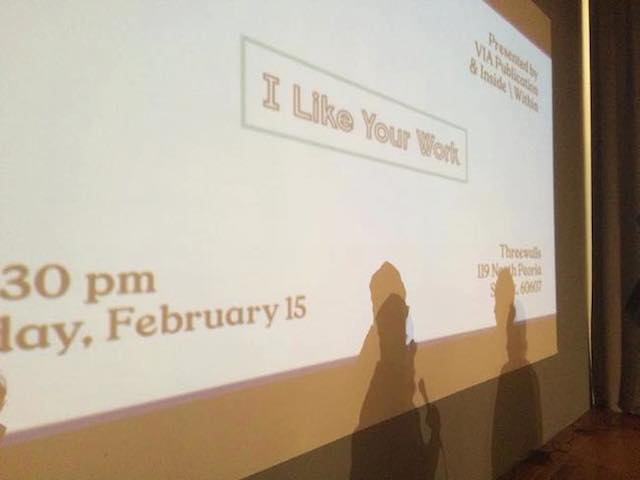I recently visited my former home, Chicago, to cohost a public program that I organize with fellow founding editors of Los Angeles–based print magazine VIA Publication. “I Like Your Work” is a series of shotgun interviews between cultural practitioners and their admirers, addressing questions about the current state of their creative practices in their respective industries. For this iteration of the event, we extended the program to another city, to gain perspectives on cultural labor and practice from other geographical locations. To fully realize the evening, we collaborated with Chicago-based magazine Inside\Within, founded by writer Kate Sierzputowski with the mission of documenting artist studios in Chicago. Located above a steep staircase in a West Loop warehouse, Threewalls Gallery hosted two hours of lucid conversation between ten cultural producers living and working in Chicago. During the evening, we heard from a wide range of writers, artists, and curators about how and why they work: intimate discussions between two people in front of an audience of many spectators.
I was struck by the eight-minute conversation between Lise Haller Baggesen and Assaf Evron, in which they approached a rare topic: nourishment in art. What initially intrigued me was their discussion on the mediation between parenting and artistic practice: how do the two complement or provoke one another? Or, in the case of Baggesen, how does parenting come through in her art process? Evron, an Israeli artist and father based in Chicago, makes art that differs dramatically from Baggesen’s and is not as obviously influenced by parenting. Yet their dialogue navigated the breadth and messiness of parenting and art practice in academia.
Baggesen, like many cultural workers today, has a multifaceted practice, spanning the use of the exhibition space as material and the written word. This is strikingly conveyed in her latest project, Mothernism, a series of nomadic, tented environments for conversation, reading, lactating, partying, and introspection. Within the tents, Baggesen used text in an audio track; recently she has returned it to its original form, the written letter. Baggesen’s book, an extension of the project, is also titled Mothernism (Poor Farm / Green Lantern, 2014). Bound between the shiny violet covers is a series of eight letters to her children, sister, and mother. Feminist artists, writers, and muses in recent contemporary–art history appear in the letters, to illustrate Baggesen’s theories and anecdotes—a need for the mother to have a discourse in contemporary art.
The term mothernism is full of irony, riffing on modernism—it’s a fun play on words. Baggesen could have stopped after simply mentioning her critique of what she calls the “mother-shaped hole” in contemporary art. But she kept going: her motivation is to shed light on projects with affective subject matter that have veered away from any serious critical writing and discourse. The book Mothernism confronts this. The collection is experimental and undeniably personal yet unapologetically critical, with references to science fiction and disco and accompanied by a soundtrack, Donna Summer’s “Love to Love You Baby.”
In the letter titled “Mother of Intervention,” Baggesen writes in the opening paragraph to her young daughter, “People are surgically altered to look more like you and less like me,” setting the tone for an open letter on body alterations and re-imagined personas. Over the next five pages, we learn from Baggesen’s references to popular culture and art history—most notoriously, Jeff Koons and Cicciolina’s public relationship of the ’80s and early ’90s—about the desire to look perfect and the headache of striving for so-called normalcy. In “Mother of Redemption,” Baggesen addresses the letter to her sister; this results in an e–mail debate about American feminist heritage: Is it a strictly mother-daughter dynamic? And how can archival work be called feminist? The reader bears witness to Baggesen’s mothering pedagogy, which is the bottom line of these personal letters.
In previous years, the letter has been disregarded by contemporary writers and critics, who deemed it a feminine, Victorian-era form: the first-person singular pronoun “I” could not be sufficiently critical and was often associated with personal emotion and sensitivity. But recently, there’s been a resurgence of the letter format, especially in art writing (see recent titles like Sternberg Press’s Dear Navigator by Hu Fang or Semiotext(e)’s Native Agent series, publishing works by writers such as Eileen Myles). Baggensen embraces the “I,” using the personal to drive the critical effectiveness of self-awareness, mothering, and agency. What results is a very personal dialogue between Baggesen and her recipients.
